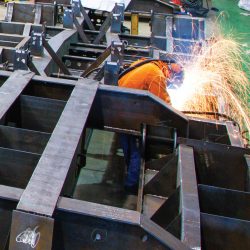The trucking industry provides a valuable service to many of us but does so almost invisibly. While most people spend their work days inside, the tools we use and the products we consume are more than likely delivered to us through a complex network of trucks that we only see on roads during the daily commutes. However, there is a lot of change happening in the industry and the future looks brighter than ever.
A focus on safety
Safety has been a top priority for both truck drivers and the people who design, manufacture and service heavy haulage vehicles. Making sure the right vehicles are matched to the quality of the road network is something the National Heavy Vehicle Regulator has been spearheading for several years, and we’re pleased to see the new possibilities for safety that automated vehicles can bring.
Automated or driver-assisting vehicles use a network of cameras, sensors and a connection to other similarly-equipped vehicles in the area to get a comprehensive view of the entire area around the truck, not just what the driver can see. This view is connected to the vehicle controls to brake and steer out of harm’s way, ensuring every trip is a safe one.
An extra emphasis on driver skills
While automation is touted as a turn-key solution to the issues of driver fatigue in long-range trips, it’s only one part of a heavy haulage job. Futurists predict that no amount of computer-aided driving will replace the skills required for areas between long highways and the final destination. This includes problematic areas like complex docking bays, unmarked roads or parking areas that have no documentation.
It’s relatively easy to get a computer to drive along a straight line, but it’s entirely another thing to navigate a busy rural town with no clear indicators of where to go next. A driver’s skill will be, as it has always, found in using local knowledge and experienced know-how to get the cargo to its intended destination.
A new look at preventative maintenance
Predictive diagnostics, where the vehicle can let you know what is happening under the hood and highlight any potential issues, is definitely the way of the future. A complex array of sensors continually monitor every part of the vehicle, from the engine through to the wheels, for any potential defect or anachronism.
These are then reported to a base station where engineers and repair technicians can fix the problem well in advance of it turning into a catastrophe. This technology is designed to not only keep trucks running longer and more reliably, but also prevent drivers from being stranded out in the middle of nowhere with no immediate help available.
Busier drivers, more efficient drives
A recent study showed that anywhere between 20% and 40% of long-distance truck trips may be done with a completely empty haul. This is because of manually-organised scheduling, where jobs are not organised with maximum efficiency. This is something computer automation can assist scheduling managers with easily.
For example, automated scheduling software that is cloud-connected can have a larger awareness of all the potential jobs that await a truck after it has dropped off its load at the destination and before it makes the trek back home. It can alert the driver or manager about the job and arrange for the new load to be picked up far quicker than what it would have taken with a series of phone calls and negotiations.
All of these advancements show that the future for truck drivers and operators is a bright exciting one. At The Drake Group we’ve been supporting our partners in the industry by supplying a comprehensive range of custom designed and capable heavy haulage trailers for 60 years. Contact The Drake Group today to see how we can help your business move into the future.
